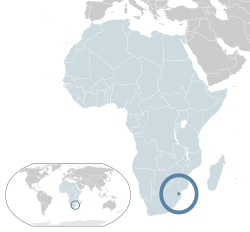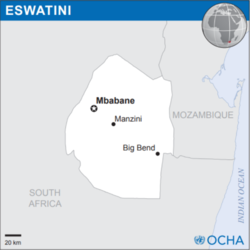Eswatini
Kingdom of Eswatini Umbuso weSwatini(Swazi) | |
|---|---|
| Motto: "Siyinqaba"(Swazi) "We are a fortress" "We are a mystery" "We hide ourselves away" "We are powerful ones" | |
| Anthem: "Nkulunkulu Mnikati wetibusiso temaSwati" "Oh God, Bestower of the Blessings of the Swazi'" | |
 Location ofEswatini(dark blue) – inAfrica(light blue) | |
 | |
| Capital | 26°30′S31°30′E/ 26.500°S 31.500°E |
| Largest city | Mbabane |
| Official languages | English |
| National language | Swazi |
| Demonym(s) | Swazi |
| Government | Unitaryparliamentaryabsolutediarchy |
| Mswati III | |
| Russell Dlamini | |
| Legislature | Parliament |
| Senate | |
| House of Assembly | |
| Independence from theUnited Kingdom | |
• Granted | 6 September 1968 |
| 24 September 1968 | |
| 2005[1][2][3] | |
| Area | |
• Total | 17,364 km2(6,704 sq mi) (153rd) |
• Water (%) | 0.9 |
| Population | |
• 2021 estimate | 1,192,271[4][5](155th) |
• 2017 census | 1,093,238[6] |
• Density | 68.2/km2(176.6/sq mi) (135th) |
| GDP(PPP) | 2019 estimate |
• Total | $12.293 billion |
• Per capita | $11,089[7] |
| GDP(nominal) | 2019 estimate |
• Total | $4.662 billion |
• Per capita | $4,206[7] |
| Gini(2015) | high |
| HDI(2019) | medium·138th |
| Currency |
|
| Time zone | UTC+2(SAST) |
| Driving side | left |
| Calling code | +268 |
| ISO 3166 code | SZ |
| Internet TLD | .sz |
Website www | |
Eswatini(orSwaziland) is a country inAfrica.It is officially theKingdom of Eswatini(Umbuso weSwatini). It was calledSwazilanduntil April 2018.
ItscapitalisMbabane.The country is named after the 19th-century kingMswati II.Eswatini wascolonizedby theBritishand theBoersat the end of the 19th century.[10]
Eswatini is a small country. It is no more than 200 kilometres (120 mi) north to south and 130 kilometres (81 mi) east to west. It is completely surrounded by land. Eswatini does not touch thesea.The two countries that touch it areMozambiqueandSouth Africa.The country's two largest cities are theadministrativecapitalMbabaneand the economic centerManzini.The seat of government is Lobamba.
On 19 April 2018, the King of EswatiniMswati IIIannounced that the Kingdom of Swaziland had renamed itself the Kingdom of Eswatini.[11]Part of the reason was that the old name sounded too similar toSwitzerland.[11][12]
Health[change|change source]
Eswatini is strongly affected byHIVandAIDS.The 2012CIA World Factbookshowed Swaziland with the highest HIV infection rate in the world.Life expectancyis 50 years.
Education[change|change source]
Education in Eswatini is free at primary level, mainly 1st and 2nd grades. It is also free for orphaned and vulnerable children. Children are not required to attend.[13]In 1996, the primary school enrollment rate was 90.8%. Girls and boys both attended at the primary level.[13]In 1998, 80.5% of children reached grade five.[13]
The University of Eswatini provides higher education.
Demographics[change|change source]

Most of Eswatini’s people are ethnicallySwazi.There is also a small number ofZuluand white Africans, mostly people ofBritishandAfrikanerdescent. Eswatini also has somePortuguesesettlers and African refugees fromMozambique.
82.70% of the people areChristian.Christianity in Eswatini is sometimes mixed with traditional beliefs and practices. Some people think of the king as having a spiritual role. Eswatini also has a smallMuslim minority.
Swazi have beensubsistence farmersand herders. They now mix such activities with work in the growing urban economy and in government. Some Swazi work in the mines inSouth Africa.
SiSwatiandEnglishare the official languages.[14]SiSwati has 2.5 million speakers and is taught in schools. It is also one of the official languages of South Africa.
About 76,000 people in the country speakZulu.[15]Tsongais spoken by about 19,000 people in Swaziland.Afrikaansis also spoken by some residents ofAfrikanerdescent.

Districts[change|change source]
Eswatini is divided into four districts:
Cities[change|change source]
The cities in Eswatini are:
| Rank | City | Census 1986 | Census 1997 | Calc. 2005 | District |
|---|---|---|---|---|---|
| 1. | Manzini | 46,058 | 78,734 | 110,537 | Manzini |
| 2. | Mbabane | 38,290 | 57,992 | 76,218 | Hhohho |
| 3. | Big Bend | 9,676 | 9,374 | 10,342 | Lubombo |
| 4. | Malkerns | 4,830 | 7,400 | 9,724 | Manzini |
| 5. | Nhlangano | 4,107 | 6,540 | 9,016 | Shiselweni |
| 6. | Mhlume | 6,509 | 7,661 | 8,652 | Lubombo |
| 7. | Hluti | n.a. | 5,806 | 6,763 | Shiselweni |
| 8. | Simunye | 8,762 | 5,633 | 6,512 | Lubombo |
| 9. | Siteki | 2,271 | 4,157 | 6,152 | Lubombo |
| 10. | Piggs Peak | 3,223 | 4,581 | 5,750 | Hhohho |
| 11. | Lobamba | n.a. | 3,625 | 4,557 | Manzini |
| 12. | Ngomane | n.a. | 3,902 | 4,511 | Lubombo |
| 13. | Vuvulane | n.a. | 3,594 | 4,155 | Lubombo |
| 14. | Mpaka | 1,007 | 2,144 | 3,586 | Lubombo |
| 15. | Kwaluseni | n.a. | 2,701 | 3,395 | Manzini |
| 16. | Bhunya | 3,361 | 2,650 | 3,046 | Manzini |
| 17. | Mhlambanyatsi | 2,075 | 2,553 | 2,886 | Manzini |
| 18. | Mondi | 2,886 | 2,703 | 2,872 | Hhohho |
| 19. | Tabankulu | 4,651 | 2,551 | 2,815 | Lubombo |
| 20. | Hlatikulu | 1,276 | 2,076 | 2,748 | Shiselweni |
| 21. | Bulembu | 4,850 | 2,443 | 2,260 | Hhohho |
| 22. | Kubuta | n.a. | 1,750 | 2,038 | Shiselweni |
| 23. | Tjaneni | 3,682 | 2,250 | 1,899 | Lubombo |
| 24. | Sidvokodvo | 1,339 | 1,528 | 1,746 | Manzini |
| 25. | Lavumisa | 850 | 1,117 | 1,300 | Shiselweni |
| 26. | Ngwenya | 445 | 842 | 1,281 | Hhohho |
| 27. | Nsoko | 2,868 | 963 | 1,175 | Lubombo |
| 28. | Mankayane | 913 | 1,040 | 1,144 | Manzini |
References[change|change source]
- ↑"Laws"(PDF).wipo.int.Retrieved2019-12-27.
- ↑"THE CONSTITUTION OF THE KINGDOM OF SWAZILAND ACT"(PDF).Archived fromthe original(PDF)on 29 September 2019.Retrieved29 September2019.
- ↑"Constitution"(PDF).gov.sz.Retrieved2019-12-27.
- ↑"World Population Prospects 2022".population.un.org.United Nations Department of Economic and Social Affairs,Population Division.RetrievedJuly 17,2022.
- ↑"World Population Prospects 2022: Demographic indicators by region, subregion and country, annually for 1950-2100"(XSLX).population.un.org( "Total Population, as of 1 July (thousands)" ).United Nations Department of Economic and Social Affairs,Population Division.RetrievedJuly 17,2022.
- ↑"Swaziland Releases Population Count from 2017 Census".United Nations Population Fund. Archived fromthe originalon 7 August 2018.Retrieved7 August2018.
- ↑7.07.1"Report for Selected Countries and Subjects".imf.org.
- ↑"Swaziland – Country partnership strategy FY2015-2018".World Bank.Retrieved8 March2015.
- ↑"Human Development Reports – Eswatini (Kingdom of) – Human Development Indicators".United Nations Development Programme.May 2021.Retrieved18 May2021.
- ↑Kuper, Hilda (1963).The Swazi: a South African kingdom.Internet Archive. Holt, Rinehart and Winston. pp. 10–13.ISBN978-0-03-042615-5.
- ↑11.011.1"Swaziland king changes the country's name".BBC News.2018-04-19.Retrieved2018-04-19.
- ↑"Kingdom of Swaziland Change Now Official".Times Of Swaziland.18 May 2018.Retrieved25 May2018.
- ↑13.013.113.2"2001 Findings on the Worst Forms of Child Labor".Bureau of International Labor Affairs,U.S. Department of Labor.2002. Archived fromthe originalon 15 May 2009.Retrieved29 December2009.
- ↑U.S. Department of State."Background Note:Swaziland".Retrieved29 December2009.
- ↑M. Paul Lewis (2009)."Ethnologue: Languages of the World, Sixteenth edition".Retrieved29 December2009.



